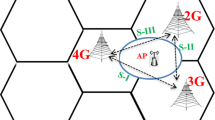Abstract
The popularity of diverse wireless communication systems has led to increased strains on the unlicensed spectrum. However, investigations have shown that vast portions of the licensed spectrum remain underutilized across frequency, space and time. To improve the utilization of the existing radio spectrum, cognitive radio (CR) allows a secondary system to access the licensed spectrum as long as the primary system’s operation is not compromised. Two main CR transmission modes, spectrum overlay and underlay have been proposed. In the spectrum overlay mode, challenges in quality-of-service (QoS) provisioning arise due to the necessity for secondary users to vacate the channels when a primary user appears. In the underlay model, interference caused to the primary system has to be carefully managed resulting in a constraint of the secondary system’s transmit power, which causes difficulty in QoS provisioning. In this paper, we propose an elastic bandwidth allocation scheme to make concurrent use of both spectrum overlay and underlay transmission modes. Different from existing hybrid transmission strategy, our scheme employ a novel softened peak interference power constraint to improve the performance of the secondary system while still granting the superior protection to the primary system transmissions. This allows the proposed scheme to achieve a superior transmission capacity in the CR network while avoiding the weaknesses of the both spectrum overlay and spectrum underlay transmission modes.








Similar content being viewed by others
References
Valenta, V., Marslek, R., Baudoin, G., et al. (2010). Survey on spectrum utilization in Europe: Measurements, analyses and observations. In Cognitive Radio Oriented Wireless Networks & Communications (CROWNCOM), 2010 Proceedings of the Fifth International Conference on (pp. 1–5).
Mitola, J, I. I. I., & Maguire, G. Q, Jr. (1999). Cognitive radio: making software radios more personal. IEEE Personal Communications, 6, 13–18.
Akyildiz, I. F., Lee, W.-Y., Vuran, M. C., & Mohanty, S. (2008). A survey on spectrum management in cognitive radio networks. IEEE Communications Magazine, 46, 40–48.
Goldsmith, A., Jafar, S. A., Maric, I., & Srinivasa, S. (2009). Breaking spectrum gridlock with cognitive radios: an information theoretic perspective. Proceedings of the IEEE, 97, 894–914.
Weiss, T., Hillenbrand, J., Krohn, A., & Jondral, F. K. (2004). Mutual interference in OFDM-based spectrum pooling systems. In IEEE 59th Vehicular Technology Conference, 2004. VTC 2004-Spring (Vol. 1874, pp. 1873–1877).
Karipidis, E., Larsson, E. G., & Holmberg, K. (2009). Optimal scheduling and QoS power control for cognitive underlay networks. In 3rd IEEE International Workshop on Computational Advances in Multi-Sensor Adaptive Processing (CAMSAP) (pp. 408–411).
Kang, X., Garg, H., Liang, Y.-C., & Zhang, R. (2010). Optimal power allocation for OFDM-based cognitive radio with new primary transmission protection criteria. IEEE Transactions on Wireless Communications, 9, 2066–2075.
Wei, G., Xiang, Y., Ji, M., & Zhu, P. (2014). An analytical model for optimal spectrum leasing under constraints of quality of service in CRNs. Computer Networks. Part B, 74, 71–80.
Hu, D., & Mao, S. (2013). On co-channel and adjacent channel interference mitigation in cognitive radio networks. Ad Hoc Networks, 11, 1629–1640.
Sidhu, G. A. S., Feifei, G., Wei, W., & Wen, C. (2013). Resource allocation in relay-aided OFDM cognitive radio networks. IEEE Transactions on Vehicular Technology, 62, 3700–3710.
Zhang, R. (2009). On peak versus average interference power constraints for protecting primary users in cognitive radio networks. IEEE Transactions on Wireless Communications, 8, 2112–2120.
Saleem, Y., & Rehmani, M. H. (2014). Primary radio user activity models for cognitive radio networks: A survey. Journal of Network and Computer Applications, 43, 1–16.
Author information
Authors and Affiliations
Corresponding author
Rights and permissions
About this article
Cite this article
How, K.C., Ma, M. & Qin, Y. Elastic bandwidth allocation scheme with softened peak interference power constraint for the dynamic cognitive radio systems. Wireless Netw 22, 1699–1709 (2016). https://doi.org/10.1007/s11276-015-0961-9
Published:
Issue Date:
DOI: https://doi.org/10.1007/s11276-015-0961-9




